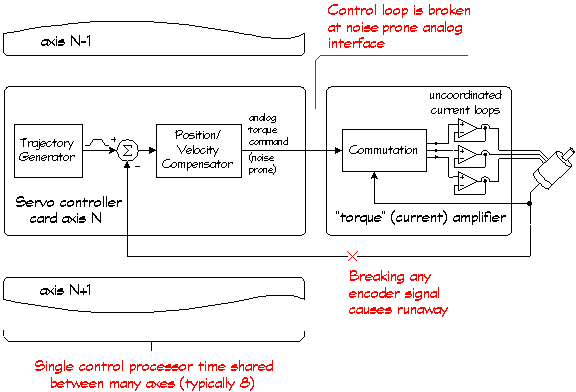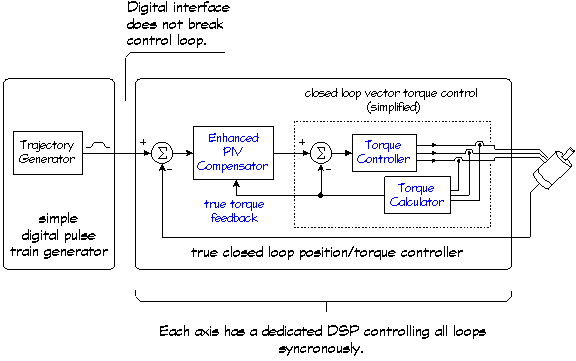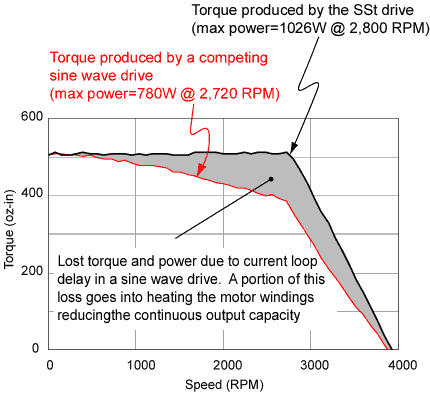 |
You should
notice several things about this block diagram.
1. The vector torque controller
actively measures and controls the actual torque (force) to the
level that is requested by the Position/Velocity compensator. This is
done by measuring all of the motor currents simultaneously and calculating
both the vector amplitude and the vector angle of the resultant
magnetic field (hence the term vector torque control) and locking this
magnetic field to the rotor's position to produce the exact amount of
torque requested. In addition to being accurate, this technique also reduces
the torque response delay to a constant level, independent of the rate
of change of torque demand, motor speed, shaft angle, or "quadrant" of
operation. What this means is that the Position/Velocity compensator does
not have to be "de-tuned" to accommodate the variable delay and variable
amplitude response of an open loop "torque" amp. This leads to superior
smoothness, enhanced disturbance rejection and short settling times.
(After you read this section see the Closed-Loop
Vector Torque Control feature for a good description of how this works.)
2. There is no analog noise inserted
within any of the control loops. The compensator/torque-controller interface
is all-digital and free of any analog noise contribution or decreased
resolution. The interface to the servo system is instead placed outside
of the control loops at the trajectory command level. This digital
interface is a pulse stream which is easily and inexpensively produced
by a stepper motor indexer, or a couple of output bits on an embedded
CPU, or a PC's parallel port, or with a PLC's timer/pulser output.
(In fact, the SST servo drive's RAS feature
greatly aids in the use of simple schemes for generating the trajectory
pulse streams, and automatically converts simple, linear velocity profiles
into smooth, jerk limited profiles. After you read this page see the Zero-cost
controller capability feature for more detail on this).
3. Inside a Totally-Digital Servo
with VTC, the Position/Velocity compensator is completely synchronized
with the vector torque control. There is no accumulation of sample time
delays and the Total Servo Phase Delay (TSPD) can be as short as the raw
time it takes to do the control calculations. In fact, the SST servo drive's
TSPD (the elapsed time from when the encoder feedback and currents are
read until the PWM outputs to the motor are modulated) is only 50 microseconds!
TSPD has much greater effect on servo performance than the often-cited
controller sample time. The SST servo drive is without peer in regard
to this TSPD specification. (After you read this page see the Lowest
TSPD on the market feature for more detail on this).
4. Servo runaway due to lost
or faulty encoder signals can not occur. Because the rotation of the magnetic
vector is tightly linked to the encoder signals, loss of either encoder
phase signal will stop the servo dead. These systems are therefore far
more fail-safe than a traditional servo system even when used with TTL
(inexpensive) encoders (where electrical loss of the encoder signal is
undetectable).
5. Control Synergy—The dedicated
DSP processor within the SST servo drive knows, at all times: the state
of the Position/Velocity compensator, the motor's magnetic field, the
output voltages of the amplifier, the limit switch inputs, the RMS current
in the motor, and a number of other variables. The SST's proprietary control
algorithms have been specifically designed to make good use of all this
information. The result has been superior performance in not only standard
benchmarks (bandwidth, settling time, tracking accuracy), but also in
subjective benchmarks such as quiet jitter-free operation, virtual elimination
of overshoot, reduction of torque "chatter", and more. In addition, the
DSP's knowledge of the entire state of the system has enabled WorldServo
to produce several unique features. Thousands of hours of computer simulation
and experimentation yielded, among other advantages, optimized operation
of: Adaptive Inertia Matching Technology (IMT), Hard-stop homing, fuzzy
MoveDone signal false trigger suppression, and automatic current sensor
calibration. (To find out more about these features and their associated
benefits go to the Features/Benefits page.).
|








